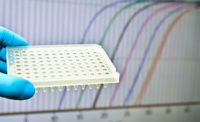If time is money, then the ability to rapidly test for pathogens is the key to potentially vast savings for meat and poultry processors.
The more time it takes to analyze protein samples in locations, the more likely companies will need to discard meats because of shorter shelf lives.
While analysts note it often takes between 12 and 48 hours to conduct tests and receive results, a move to expedite the process is taking shape.
“A validated pathogen test is necessary for companies to release product,” says Jesse Miller, director of the Applied Research Center for NSF International, an Ann Arbor, Mich.-based food safety auditing firm and standards developer. “But the longer it is for the release, the greater the chance of product waste. As a result, manufacturers of test kits are working to have results available during a single shift.”
Chemical and technological advancements are resulting in faster and more accurate rapid testing, he says.
“Technologies exist that can detect single organisms with high precision,” Miller says. “But sensitive detection isn’t the issue. The issue is finding the one bacteria in your sample that will turn into millions, if not billions, on the shelf. That is crucial because federal regulations dictate that there are zero pathogens in foods.”
Most tests are relatively lengthy because of the need to enrich samples to bring a bacterial population to detectable levels, he says, adding that operators are seeking to streamline the procedure by using enhanced optics for detectors in conjunction with enrichment broths that reduce background flora while stimulating the growth of target organisms.
“Detecting one organism in a sample is very difficult,” Miller says. “You need it to replicate itself to detectable levels.”
Pinpoint pathogens
It also is crucial for processors to detect contamination in a particular zone of a processing facility and/or during a shift to enable targeted intervention and prevent contamination spread and unnecessary meat product wastage, says Carmen Gomes, associate professor of mechanical engineering in the Department of Engineering at Iowa State University in Ames.
“That allows for pathogen monitoring and sanitation efficacy so that corrections can be made before food products become compromised,” she says, but adds that testing remains time-consuming and costly.
Current techniques for detecting pathogens, such as total viable counts (TVC), polymerase chain reaction (PCR) and enzyme-linked immunosorbent assays (ELISA), require laboratories with highly trained personnel, and some tests require environmentally hazardous reagents, Gomes says.
The labs use food or swab samples taken from processing plants to detect pathogens. Lab technicians typically have to use personal protective equipment, including goggles, lab coats and gloves, to carry out the procedures, she says. Reagents include organic solvents, acids and bases, surfactants and enzymes that technicians must properly discard after use to reduce the environmental impact.
Detecting pathogens typically takes a day or two because of the pre-enrichment process, she says. That process usually is followed by a selective enrichment step, leaving processors to hold product in cold storage until they receive test results.
“This practice is not cost effective as it requires the constant expense of operating chillers and reducing the overall shelf life of products,” Gomes says.
“While a single test costs between 10 and 20 dollars, those costs do not account for the overhead associated with maintaining a well-staffed laboratory testing facility,” she says. “Reducing the overall time requirement and cost per test would ensure that processors could effectively run more tests to minimize the risk of foodborne illness outbreaks.”
Eliminating the pre-enrichment of a sample before testing would enable operators to quicken the process while cutting expenses, she says. Pre-enrichment consists of allowing bacteria to grow to numbers that are detectable for testing.
“The current techniques all require bacterial enrichment, which involves incubating samples with growth medium for 24 to 48 hours in order to amplify the number of bacteria prior to detection,” Gomes says. “That is necessary as current testing methods lack sensitivity detection and cannot detect lower levels of pathogens in complex samples like media, broth or homogenized tissue.”
Other user-friendly testing methods for in-field applications also require pre-concentration steps in order to create the pathogen to levels that can be detected. Pre-concentration methods include the use of filters, followed by filtration, to concentrate bacteria, Gomes says. Methods also require functionalizing magnetic particles with antibodies or another bio-recognition agent specific to the pathogen. Once added to the sample, the magnetic particles bind to the bacteria surface and isolate the bacteria for further testing.
No time to waste
While accurate testing is essential for detecting pathogens in meat and poultry, it also is important for operators to frequently test in order to identify possible contamination early and reduce the amount of product that processors may need to discard, says Norman Marriott, emeritus professor in the College of Agriculture and Life Sciences at Virginia Polytechnic Institute and State University (Virginia Tech) in Blacksburg.
“There should be testing on every lot or batch as soon as possible following product development,” he says. “Plant workers that discover bacteria after an entire day’s production must discard all the meat products. But pinpointing contamination after just two hours of production might only require the jettison of the particular batch.”
Though rapid testing still takes longer than many operators would prefer, Marriott says evolving technologies will eventually enable quicker readings. “Decade ago there might have been a two- to five-day wait time,” he says.
Even with more rapid test results, meat can still be tainted after analysis if workers handle and contaminate clean proteins or the products come in contact with contaminated machinery, he says.
“Even the sampling equipment itself can be contaminated,” Marriott says. “So it is important that plant operators train employees to follow the appropriate testing procedures and that there is effective supervision, particularly for less-experienced employees.”
Ensuring workers follow strict protocols during the entire testing procedure is crucial, regardless of who performs the tests, he says, noting third-party contractors often conduct tests for smaller processors, and in-house personnel usually perform rapid testing for larger operators.
“The objective is not to make the results turn out favorably, but to get accurate results, whatever they are,” Marriott says. NP







Report Abusive Comment